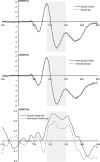Social processing modulates the initial allocation of attention towards angry faces: evidence from the N2pc component
- PMID: 37971294
- PMCID: PMC10689156
- DOI: 10.1093/scan/nsad070
Social processing modulates the initial allocation of attention towards angry faces: evidence from the N2pc component
Abstract
Previous research has shown that attentional bias towards angry faces is moderated by the activation of a social processing mode. More specifically, reliable cueing effects for angry face cues in the dot-probe task only occurred when participants performed a task that required social processing of the target stimuli. However, cueing effects are a rather distal measure of covert shifts in spatial attention. Thus, it remains unclear whether the social processing mode modulates initial allocation of attention to or attentional disengagement from angry faces. In the present study, we used the N2pc, an event-related potential component, as an index of attentional shifts towards angry faces. Participants performed a dot-probe task with two different target conditions while the electroencephalogram (EEG) was recorded. In the social target condition, target stimuli were socially meaningful (schematic faces), and in the non-social target condition, they were meaningless (scrambled schematic faces). The amplitude of the N2pc component elicited by angry face cues was significantly larger in the social target condition than in the non-social target condition. This pattern also occurred for behavioural cueing effects. These results suggest that the activation of a social processing mode due to current task demands affects the initial allocation of attention towards angry faces.
Keywords: N2pc component; angry faces; attentional bias; dot-probe task; social processing.
© The Author(s) 2023. Published by Oxford University Press.
Conflict of interest statement
The authors declared that they had no conflict of interest with respect to their authorship or the publication of this article.
Figures




Similar articles
-
Attentional bias towards angry faces is moderated by the activation of a social processing mode in the general population.Cogn Emot. 2019 Nov;33(7):1317-1329. doi: 10.1080/02699931.2018.1561423. Epub 2018 Dec 26. Cogn Emot. 2019. PMID: 30587095
-
It occurs after all: Attentional bias towards happy faces in the dot-probe task.Atten Percept Psychophys. 2020 Jul;82(5):2463-2481. doi: 10.3758/s13414-020-02017-y. Atten Percept Psychophys. 2020. PMID: 32236834 Free PMC article.
-
Furious snarling: Teeth-exposure and anxiety-related attentional bias towards angry faces.PLoS One. 2018 Nov 27;13(11):e0207695. doi: 10.1371/journal.pone.0207695. eCollection 2018. PLoS One. 2018. PMID: 30481190 Free PMC article.
-
Electrophysiological evidence of attentional biases in social anxiety disorder.Psychol Med. 2009 Jul;39(7):1141-52. doi: 10.1017/S0033291708004820. Epub 2008 Dec 15. Psychol Med. 2009. PMID: 19079826 Free PMC article.
-
Current status of the anger superiority hypothesis: A meta-analytic review of N2pc studies.Psychophysiology. 2021 Jan;58(1):e13700. doi: 10.1111/psyp.13700. Epub 2020 Oct 11. Psychophysiology. 2021. PMID: 33040366 Review.
References
-
- Anderson A.K. (2005). Affective influences on the attentional dynamics supporting awareness. Journal of Experimental Psychology: General, 134(2), 258–81. - PubMed
-
- Bar-Haim Y., Lamy D., Pergamin L., Bakermans-Kranenburg M.J., van Ijzendoorn M.H. (2007). Threat-related attentional bias in anxious and nonanxious individuals: a meta-analytic study. Psychological Bulletin, 133(1), 1–24. - PubMed
-
- Barratt D., Bundesen C. (2012). Attentional capture by emotional faces is contingent on attentional control settings. Cognition & Emotion, 26(7), 1223–37. - PubMed
-
- Becker S.I., Folk C.L., Remington R.W. (2013). Attentional capture does not depend on feature similarity, but on target-nontarget relations. Psychological Science, 24(5), 634–47. - PubMed
-
- Belopolsky A.V., Schreij D., Theeuwes J. (2010). What is top-down about contingent capture? Attention, Perception, & Psychophysics, 72(2), 326–41. - PubMed

